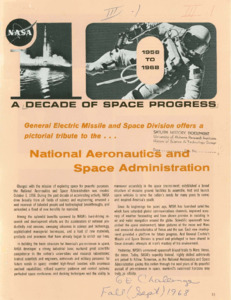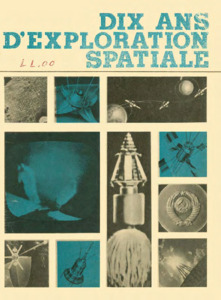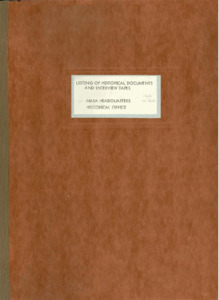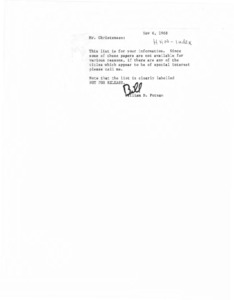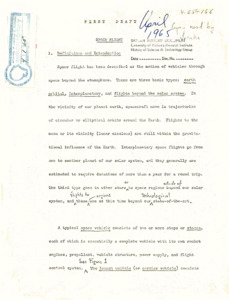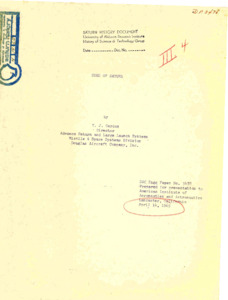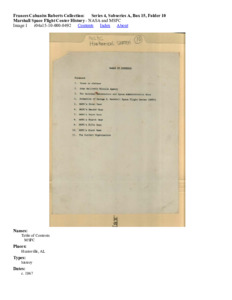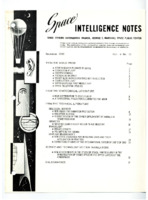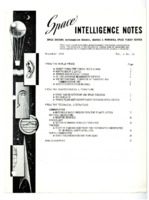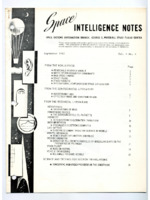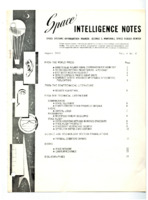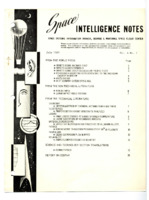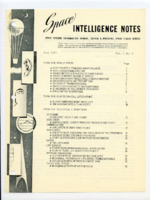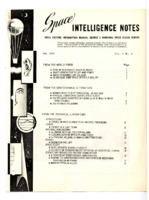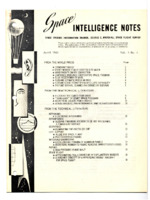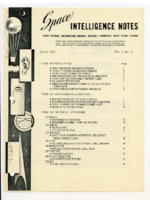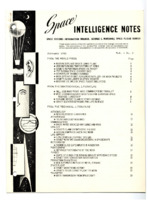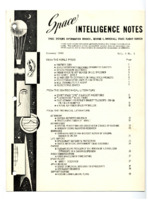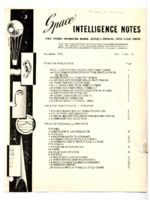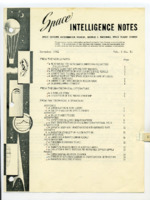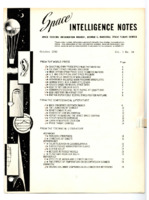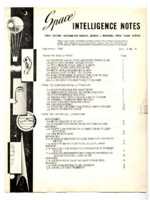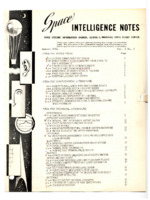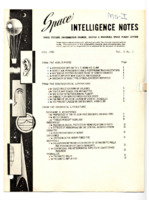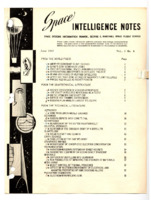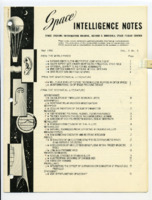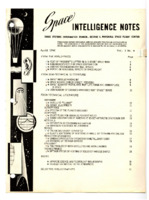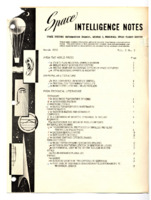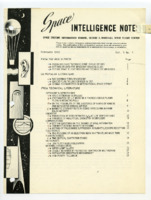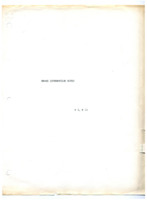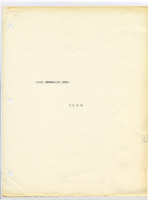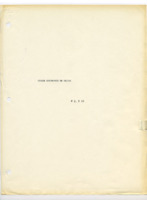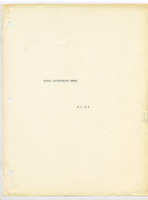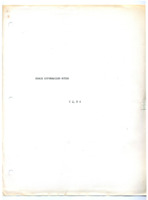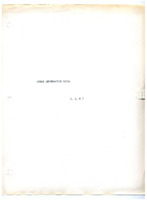
Browse Items (132 total)
Sort by:
-
"A decade of space progress, 1958 to 1968: General Electric Missile and Space Division offers a pictorial tribute to the National Aeronautics and Space Administration."
Excerpt from G.E. Challenge, Fall (Sept.) 1968, pages 13 to 25. -
"Dix ans D'exploration Spatiale."
A series of french articles related to the space program. -
"Listing of Historical Documents and Interview Tapes."
Archive copy is a poor photocopy.; Handwritten on the first page is "10/25/67".; Includes a letter dated Nov. 6, 1968 to Mr. Christensen from William D. Putnam. -
"Master list of projects."
Note attached to document to Mr. Christensen from William D. Putnam. List of projects ordered by criteria. -
"Propulsion : the key to space travel."
Cover has: P. D. Castenholz and H. K. Griggs, Advanced Systems, Advanced Projects Department. D. W. Hege, Manager, Advanced Projects. Paper regarding the importance of propulsion technology and the future missions that would require advancements in that field. -
"Space flight : first draft."
Appears to be a rough dfraft with editorial comments and revision notes. Includes references to figures and tables.; Page 31 is missing. Pages 37 through 44 do not exist; there is a note about this on page 36. Page 67 also does not exist. -
"Uses of Saturn."
Saturn and Apollo hardware will not have realized their ultimate potential for space exploration after the project lunar landing is complete. To accomplish the Apollo lunar landing program, an immense backlog of technology, facilities, and booster capability will have been built up, and we believe proper utilization of this resource will fill the needs for planetary, lunar and earth orbital space exploration for years to come. -
Oral History Interview With Robert McBrayer
After Robert McBrayer graduated college, he reported to the Johnson Space Center in March of 1963. He was there assigned to a section called "Biodynamics" and in that section, they worked on Human tolerances to impact sustaining acceleration and acoustics. Robert was assigned to the acoustics group, and his first job was to design and develop a machine to produce low-frequency pure tones to test humans. He also designed and developed a test chamber for testing humans, and he participated in doing the actual human test with the machines that he helped build. He helped document the results as well. After his venture in doing basic research, he went into an area called "crew's survival equipment design and development," and he was assigned pieces of equipment that were his to design, update, and help build. In 1966, Robert asked to be transferred from the Johnson Space Center to the Marshall Space Flight Center, and he then moved to Huntsville, AL. Robert was immediately put on the Orbital Workshop where they were writing task analysis, and procedures for crew station reviews. They did two of those, on in 1967 and the other in 1968. From the Orbital Workshop, he was responsible for all the crew interfaces on adapter, etc.Tags Oral History -
Oral History Interview With Michael Bacaro
Michael Bacato was born in Brooklyn, New York in 1927. When he started high school at the age of 14, Pearl Harbor was attacked by the Japanese. When he graduated high school, he enlisted in the Navy in 1945 so he wouldn't have to go into the Army. He stayed in the Navy for two years. In the Navy, Michael was on a crew of the Destroyer. When he got discharged from the Navy, he then started college in 1948. To help pay for college, he started working with the merch marines selling out oil tanks. He finished this in 1951. Michael started out in college at New York University, and soon after he almost had to go back to the Navy because North Korea invaded South Korea. To avoid going back, he joined the ROTC at NYU with the airforce. In 1952, he entered the extended active duty with the United States airforce as a second lieutenant. He went to Keesler Airforce Base for training, and he spent two years there. There, he became a Radar Officer. After his training, Michael then started to become interested with Von Braun, and the development of rockets in Huntsville, AL. He then finally made a decision to leave the airforce, and he moved to Huntsville to work. He went into the Mechanical Engineering Design group. One of the first projects he was assigned to was the life support system, working with two monkeys. He then was offered a job in the Bioengineering group, which he liked much better, so he decided to stay with this group. His last program he worked on was on the Hubble Telescope, where he had the opportunity to work with Buzz Aldron.Tags Oral History -
Marshall Space Flight Center History
NASA and MSFC -
Space Intelligence Notes, December 1963.
This is Vol. 4, No. 12 of Space Intelligence Notes, a publication of the Space Systems Information Branch at the Marshall Space Flight Center. According to the table of contents page, topics include various articles from the world press such as planned atomic research in Israel, the flight of Cosmos-21 and Cosmos-22, and the launch of Japan's first missile ship; from the semitechnical literature such as new constributions to space flight; from the technical literature includng biological sciences, chemistry, space flight, and units and measurements; science and technology section translations; and bibliographies. -
Space Intelligence Notes, November 1963.
This is Vol. 4, No. 11 of Space Intelligence Notes, a publication of the Space Systems Information Branch at the Marshall Space Flight Center. According to the table of contents page, topics include various articles from the world press such as rocket firing progress in India, the election of a new president, and the exchange of measurement experts between the US and USSR; from the semitechnical literature such as Soviet aims in astronomy and space research; from the technical literature including communication, materials engineering, space flight, tracking, and vehicle engineering; and bibliographies. -
Space Intelligence Notes, October 1963.
This is Vol. 4, No. 10 of Space Intelligence Notes, a publication of the Space Systems Information Branch at the Marshall Space Flight Center. According to the table of contents page, topics include various articles from the world press such as ice from space, US tracking station plans, the presence of intelligent beings on Mars, and sun eruptions possibly causing atomic geysers on the Moon; from the semitechnical literature such as sun power; from the technical literature including astrogeology, life support, materials engineering, physics, theoretical physics, and nuclear physics; and bibliography. -
Space Intelligence Notes, September 1963.
This is Vol. 4, No. 9 of Space Intelligence Notes, a publication of the Space Systems Information Branch at the Marshall Space Flight Center. According to the table of contents page, topics include various articles from the world press such as re-useable research rocket, high speed cameras, Soviet plans, and space pursuits; from the semitechnical literature such as the effects of noise and vibration on man; from the technical literature including astrophysics, atmospheric physics, chemistry, instrumentation, life support, orbital mechanics, organic chemistry, space flight, and vehicle engineering; space and technology section translations; on books; and bibliographies. -
Space Intelligence Notes, August 1963.
This is Vol. 4, No. 8 of Space Intelligence Notes, a publication of the Space Systems Information Branch at the Marshall Space Flight Center. According to the table of contents page, topics include various articles from the world press such as Soviets search for international cooperation for Moon trip and the completion of Soviet Pacific Ocean shots; from the semitechnical literature; from the technical literature including communications, lasers, photography, and space flight; science and technology section translations; on books; and bibliographies. -
Space Intelligence Notes, July 1963.
This is Vol. 4, No. 7 of Space Intelligence Notes, a publication of the Space Systems Information Branch at the Marshall Space Flight Center. According to the table of contents page, topics include various articles from the world press such as the Soviets putting the first woman in space, the launch of Soviet Cosmos -18, and West Germany's entrance into the space age; from the semitechnical literature such as new isotopes; from the technical literature including chemistry, electronics, lasers, materials engineering, physics, propulsion, and reliability; science and technology section translations; and a report on COSPAR. -
Space Intelligence Notes, June 1963.
This is Vol. 4, No. 6 of Space Intelligence Notes, a publication of the Space Systems Information Branch at the Marshall Space Flight Center. According to the table of contents page, topics include various articles from the world press such as the failure of Mars I, Soviet claims that Earth as a "Saturn" ring, and the confirmation of a new atom part; from the semitechnical literature such as the Canadian satellite Alouette; from the technical literature including astronomy, biosciences, communications, geosciences, lasers, life sciences, materials engineering, theoretical physics, tracking, and vehicle engineerings; science and technology section translations; on books; and technical articles in the journal literature. -
Space Intelligence Notes, May 1963.
This is Vol. 4, No. 5 of Space Intelligence Notes, a publication of the Space Systems Information Branch at the Marshall Space Flight Center. According to the table of contents page, topics include various articles from the world press such as the new French tracking radar, Soviet generators' use of wind power, and the reality of the US-Soviet joint space effort; from the semitechnical literature such as experiences from the US and Soviet of manned space flights, physical conditioning during space flight, and the possibility of "Moon glow" and "Moon shine"; from the technical literature including astrogeology, lasers, materials engineering, physics, space flight, and science and technology section translations; on books; and bibliographies. -
Space Intelligence Notes, April 1963.
This is Vol. 4, No. 4 of Space Intelligence Notes, a publication of the Space Systems Information Branch at the Marshall Space Flight Center. According to the table of contents page, topics include various articles from the world press such as the booster size of the Soviet manned flight, the course correction of Soviet spacecraft Mars I, the announcement of U.S.-France space program, and Russian estimates of water on Mars; from the semitechnical literature such as Earth from orbit and the Moon as a power source; from the technical literature including astronomy, astrophysics, geophysics, life support, materials engineering, physics, and space flight; on books; and bibliographies. -
Space Intelligence Notes, March 1963.
This is Vol. 4, No. 3 of Space Intelligence Notes, a publication of the Space Systems Information Branch at the Marshall Space Flight Center. According to the table of contents page, topics include various articles from the world press such as the Soviet Mars 1 spacecraft, the announcement of a new French satellite tracking radar, and the details of space cooperation between Americans and Russians; from the semitechnical literature such as the "correction" of Newton by Soviet scientist, and Soviet preparations for a manned orbit flight; from the technical literature including astrionics, astronomy, astrophysics, geology, instrumentation, life support, materials fabrication, physics, space medicine, and theoretical physics; on books; and bibliographies. -
Space Intelligence Notes, February 1963.
This is Vol. 4, No. 2 of Space Intelligence Notes, a publication of the Space Systems Information Branch at the Marshall Space Flight Center. According to the table of contents page, topics include various articles from the world press such as Soviet lunar plans, the determining of the temperature of Venus, and Russian use of Swedish space flight simulators; from the semitechnical literature such as potential USSR Mars probe communication troubles, and the search for life in space; from the technical literature including astrobiology, astrophysics, communications, geology, life support, meteorology, photography, physics, production engineering, space flight, and telemetry; on books; and bibliographies. -
Space Intelligence Notes, January 1963.
This is Vol. 4, No. 1 of Space Intelligence Notes, a publication of the Space Systems Information Branch at the Marshall Space Flight Center. According to the table of contents page, topics include various articles from the world press such as the reason for sunspots and the cooperation of the U.S. and Soviet Union on three space projects; from the semitechnical literature such as the biggest telescope in Germany and the discovery of a "living fossil" in algae; from the technical literature including astronomy, astrophysics, biophysics, life support, physics, radio communication, space flight, space medicine, and support systems; on books; and bibliographies. -
Space Intelligence Notes, December 1962.
This is Vol. 3, No. 12 of Space Intelligence Notes, a publication of the Space Systems Information Branch at the Marshall Space Flight Center. According to the table of contents page, topics include various articles from the world press such as a Soviet communications satellite to be orbited, predictions that U.S. will be first to the Moon, critics of the Civilian Space Program, Soviet space failures, and the use of rockets to install cables; from the semitechnical literature such as Russian analysis of problems of space-weaponry defense and commentary on a Soviet paper; from the technical literature including astrionics, astrobiology, astrogeology, astronomy, astrophysics, metallurgy, optics, physics, production engineering, propulsion, radio communication, space flight, and theoretical physics; on books; and bibliographies. -
Space Intelligence Notes, November 1962.
This is Vol. 3, No. 11 of Space Intelligence Notes, a publication of the Space Systems Information Branch at the Marshall Space Flight Center. According to the table of contents pages, topics include various articles from the world press such as Russian claims of astronauts orbiting four miles apart, Soviet photos of thermal radiation, and the Soviet launch of Cosmos 10; from the semitechnical literature such as the description of the Vostok spaceship; from the technical literature including astrionics, astronomy, astrophysics, atmospherics, chemistry, flight mechanics, instrumentation, life sciences, physics, power, production engineering, and propulsion; on books; and selected bibliographies. -
Space Intelligence Notes, October 1962.
This is Vol. 3, No. 10 of Space Intelligence Notes, a publication of the Space Systems Information Branch at the Marshall Space Flight Center. According to the table of contents page, topics include various articles from the world press such as space-war preparations within Soviet military, the disclosure of six Soviet space failures, U.S. and Italy's new joint space program, and USSR to attempt sun data shots; from the semitechnical literature such as the Moon as a power source, the launching of Cosmos 8, lunar atmosphere creation, and the charting of space threats; from the technical literature including astronomy, astrophysics, biosciences, chemistry, communciations, geoscience, instruments, materials, metallurgy, oceanography, photography, physics, production engineering, propulsion, radio astronomy, spacecraft, and telemetry; on books, and bibliographies. -
Space Intelligence Notes, September 1962.
This is Vol. 3, No. 9 of Space Intelligence Notes, a publication of the Space Systems Information Branch at the Marshall Space Flight Center. According to the table of contents page, topics include various articles from the world press such as the possibly launch of a Soviet space laboratory station in 1963 and the report of the existance of water on the Moon; from the semitechnical literature such as Russian studies of ways to send a man to the moon and the intensification of Soviet radiation studies; from the technical literature including aerodynamics, astronomy, astrophysics, chemistry, geophysics, mechanics, metallurgy, microscopy, nuclear physics, physics, production engineering, and spacecraft; on books; and bibliographies. -
Space Intelligence Notes, August 1962.
This is Vol. 3, No. 8 of Space Intelligence Notes, a publication of the Space Systems Information Branch at the Marshall Space Flight Center. According to the table of contents page, topics include various articles from the world press such as Soviet predictions of fatal solar flares, the discovery of traces of life in meteorite, infrared photos of the Moon, and space food for cosmonauts; from the semitechnical literature such as Soviet plans to drill earth with underground rocket, Luniks II and III, and research on temperature of lightning; from the technical literature including aerodynamics, astronomy and astrophysics, atomspheric physics, cryogenics, electronics, electrical engineering, guidance, interplanetary flight, instrumentation, materials, mechanics, metallurgy, meteorology, nuclear physics, oceanography, physics, process engineering, propoulsion, space medicine, and thermodynamics; on books; and selected bibliographies. -
Space Intelligence Notes, July 1962.
This is Vol. 3, No. 7 of Space Intelligence Notes, a publication of the Space Systems Information Branch at the Marshall Space Flight Center. According to the table of contents page, topics include various articles from the world press such as Soviets asking permission to build Austrialian tracking stations and the discovery of rare type of nuclear decay; from the semitechnical literature such as Soviet investigation of galaxies and anti-matter; from the technical literature including astronomy and astrophysics, biosciences, chemistry, cryogenics, geophysics, hydraulics, materials metallugy, meteorology, nuclear power, photography, physics, and production engineering; on books; and selected bibliographies. -
Space Intelligence Notes, June 1962.
This is Vol. 3, No. 6 of Space Intelligence Notes, a publication of the Space Systems Information Branch at the Marshall Space Flight Center. According to the table of contents page, topics include various articles from the world press such as the successful first international space launchings and the release of some details from the flight of Soviet Gagarin; from the semitechnical literature such as the discovery of oxygen in the atmosphere of Venus and Russian plans for the world's largest telescope; from the technical literature including astrionics, astronomy, astrophysics, celestrial mechanics, climatology, earth sciences, ionospheric physics, instrumentation, materials, metallurgy, production engineering, and spacecraft; on books; and selected bibliographies. -
Space Intelligence Notes, May 1962.
This is Vol. 3, No. 5 of Space Intelligence Notes, a publication of the Space Systems Information Branch at the Marshall Space Flight Center. According to the table of contents page, topics include various articles from the world press such as the Russian proposal of a joint moon flight and artificial gravity to aid future cosmonauts; from the semitechnical literature such as the possibility of Russian development of thermonuclear weapons in space; from the technical literature including aerodynamics, astrophysics, geophysics, materials, metallugy, meteorology, nuclear physics, physics, process engingeering, propellants, and spacecraft; on books; and selected bibliographies. -
Space Intelligence Notes, April 1962.
This is Vol. 3, No. 4 of Space Intelligence Notes, a publication of the Space Systems Information Branch at the Marshall Space Flight Center. According to the table of contents page, topics include various articles from the world press such as the text of the U.S. President's letter on U.S.-Soviet space work and reports on biological aspects of space flight; from semi-technical literature such as Soviet missiles and the effect of space weightlessness; from technical literature including astronomy, astrophysics, geophysics, materials, physics, production engineering, spacecraft, and thermodynamics; on books; and selected bibliographies. -
Space Intelligence Notes, March 1962.
This is Vol. 3, No. 3 of Space Intelligence Notes, a publication of the Space Systems Information Branch at the Marshall Space Flight Center. According to the table of contents page, topics include various articles from the world press such as Soviet plans for an industrial complex on the Moon and Japan's increasing rocketry efforts; on popular literature such as proposals for a "stationary" satellite; from technical literature such as astronomy, atmospheric physics, bioastronautics, geophysics, mechanics, materials engineering, nuclear physics, optics, and physics; on books; and on selected bibliographies. -
Space Intelligence Notes, February 1962.
This is Vol. 3, No. 2 of Space Intelligence Notes, a publication of the Space Systems Information Branch at the Marshall Space Flight Center. According to the table of contents page, topics include various articles from the world press such as the possibility of a Russian 'asteroid bomb' threat by 1970; on popular literature such as Soviet plans to land on the Moon in 1967; from technical literature such as astronomy and astrophysics, chemistry, communications, electronis, fluid mechanics, instruments, materials engineering, meteorology, physics, and production engineering; on books; and on selected bibliographies. -
Space Intelligence Notes, January 1962.
This is Vol. 3, No. 1 of Space Intelligence Notes, a publication of the Space Systems Information Branch at the Marshall Space Flight Center. According to the table of contents page, topics include various articles from the world press such as Soviet Moon plans for 1962, on popular literature such as the Russian belief that there are people on Mars, from technical literature such as aerodynamics, celestial mechanics, cosmology, data processing, optical instruments, materials engineering, production engineering, radio astronomy, and telemetry, on books, and on selected bibliographies. -
Space Intelligence Notes, December 1961.
This is Vol. 2, No. 12, of Space Intelligence Notes, a publication of the Space Systems Information Branch at the Marshall Space Flight Center. According to the table of contents page, topics include various articles from the world press, on popular literature, from technical literature such as biochemistr, celestrial mechanics, chemistry, physics, and more, on books, and on selected bibliographies. -
Space Intelligence Notes, November 1961.
This is Vol. 2, No. 11 of Space Intelligence Notes, a publication of the Space Systems Information Branch at the Marshall Space Flight Center. Topics include the third list of NASA translations of Soviet publications, Soviet nuclear tests, the primary education of Soviet youth compared to American education, U.S. and Russian measurements of Venus, corrosion behavior of titanium alloys, Polish study of nonlinear pressure oscillations during combustion, the development of a transistorized device for registering cosmic rays by the Soviet Union, speculations on future space achievements, the Soviet Lunik II carrier vehicle and payload, and a review of Soviet literature. -
Space Intelligence Notes, October 1961.
This is Vol. 2, No. 10 of Space Intelligence Notes, a publication of the Space Systems Information Branch at the Marshall Space Flight Center. Topics include the second list of NASA translations of Soviet publications, a detailed account and analysis of the flight of the Soviet satellite Vostok II, the revealing of the international satellite communications system SPACEWARN, Russian study of anabiosis for possible use in space flight, the retardation of Earth's rotation, the development of an experimental model of an electromagnetic flowmeter by the Russians and their success in converting glass into microcrystalline materials, and various other studies conducted by the Soviets. -
Space Intelligence Notes, September 1961.
This is Vol. 2, No. 9 of Space Intelligence Notes, a publication of the Space Systems Information Branch at the Marshall Space Flight Center. Topics include NASA translations of Soviet publications, the satellite orbit of Vostok 2, the space launching of Soviet spacecraft, a reported luminescent ionosphere around Venus, Russian plans for a manned space station, possible Russian concentration on rocket shots at the Moon, new volumes available of a Soviet space publication on artificial Earth satellites, transmission into space with AM short-wave telegraph-telephone transmitters, Soviet high-speed photoelectric spectrophotometer, future Soviet space communication techniques, and various Soviet experiments, research, and discoveries. -
Space Intelligence Notes, August 1961.
This is Vol. 2, No. 8 of Space Intelligence Notes, a publication of the Space Systems Information Branch at the Marshall Space Flight Center. Topics include problems in the Soviet scientific community due to the shift of power and other changes, espionage and outer space, Soviet fishermen observe the return of two American astronauts from space, plenary session of the Commission of Radioastronomy, Soviet discussion of the Venus shot, and radar observations of Venus. -
Space Intelligence Notes, July 1961.
This is Vol. 2, No. 7 of Space Intelligence Notes, a publication of the Space Systems Information Branch at the Marshall Space Flight Center. Topics include a comparison of Soviet and American satellites, the thermal history of the moon, the Earth's third radiation belt, observations of Venus and the view that Venus does not rotate, natural Earth satellites, signal from space unidentifiable, Soviet proposal of new lunar TV satellite, and the possibility of Soviet women in space.
